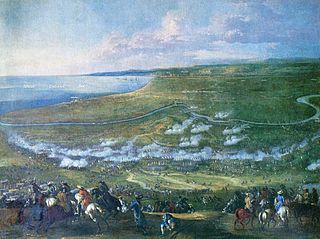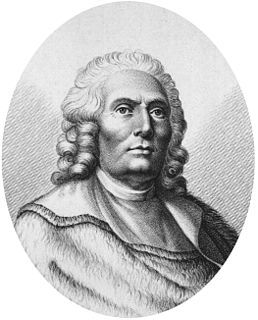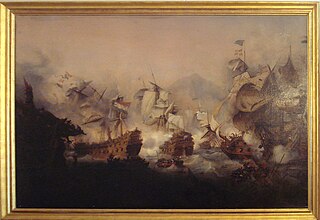| |||||
| Decades: | |||||
|---|---|---|---|---|---|
| See also: | Other events of 1676 History of France • Timeline • Years | ||||
Events from the year 1676 in France
| |||||
| Decades: | |||||
|---|---|---|---|---|---|
| See also: | Other events of 1676 History of France • Timeline • Years | ||||
Events from the year 1676 in France



The 17th century was the century that lasted from January 1, 1601, to December 31, 1700. The term is often used to refer to the 1600s, the century between January 1, 1600 and December 31, 1699. It falls into the Early Modern period of Europe and in that continent was characterized by the Baroque cultural movement, the latter part of the Spanish Golden Age, the Dutch Golden Age, the French Grand Siècle dominated by Louis XIV, the Scientific Revolution, the world's first public company and megacorporation known as the Dutch East India Company, and according to some historians, the General Crisis. The greatest military conflicts were the Thirty Years' War, the Great Turkish War, Mughal–Safavid Wars (Mughal–Safavid War, Mughal–Safavid War ), Mughal–Maratha Wars, and the Dutch–Portuguese War. It was during this period also that European colonization of the Americas began in earnest, including the exploitation of the silver deposits, which resulted in bouts of inflation as wealth was drawn into Europe.
1652 (MDCLII) was a leap year starting on Monday of the Gregorian calendar and a leap year starting on Thursday of the Julian calendar, the 1652nd year of the Common Era (CE) and Anno Domini (AD) designations, the 652nd year of the 2nd millennium, the 52nd year of the 17th century, and the 3rd year of the 1650s decade. As of the start of 1652, the Gregorian calendar was 10 days ahead of the Julian calendar, which remained in localized use until 1923.

1677 (MDCLXXVII) was a common year starting on Friday of the Gregorian calendar and a common year starting on Monday of the Julian calendar, the 1677th year of the Common Era (CE) and Anno Domini (AD) designations, the 677th year of the 2nd millennium, the 77th year of the 17th century, and the 8th year of the 1670s decade. As of the start of 1677, the Gregorian calendar was 10 days ahead of the Julian calendar, which remained in localized use until 1923.

1665 (MDCLXV) was a common year starting on Thursday of the Gregorian calendar and a common year starting on Sunday of the Julian calendar, the 1665th year of the Common Era (CE) and Anno Domini (AD) designations, the 665th year of the 2nd millennium, the 65th year of the 17th century, and the 6th year of the 1660s decade. As of the start of 1665, the Gregorian calendar was 10 days ahead of the Julian calendar, which remained in localized use until 1923.
The 1670s decade ran from January 1, 1670, to December 31, 1679.

1651 (MDCLI) was a common year starting on Sunday of the Gregorian calendar and a common year starting on Wednesday of the Julian calendar, the 1651st year of the Common Era (CE) and Anno Domini (AD) designations, the 651st year of the 2nd millennium, the 51st year of the 17th century, and the 2nd year of the 1650s decade. As of the start of 1651, the Gregorian calendar was 10 days ahead of the Julian calendar, which remained in localized use until 1923.

1676 (MDCLXXVI) was a leap year starting on Wednesday of the Gregorian calendar and a leap year starting on Saturday of the Julian calendar, the 1676th year of the Common Era (CE) and Anno Domini (AD) designations, the 676th year of the 2nd millennium, the 76th year of the 17th century, and the 7th year of the 1670s decade. As of the start of 1676, the Gregorian calendar was 10 days ahead of the Julian calendar, which remained in localized use until 1923.

Jean Desmarets, Sieur de Saint-Sorlin was a French writer and dramatist. He was a founding member, and the first to occupy seat 4 of the Académie française in 1634.

Richard Simon CO, was a French priest, a member of the Oratorians, who was an influential biblical critic, orientalist and controversialist.

Anne-Hilarion de Costentin, Comte de Tourville was a French naval commander who served under King Louis XIV. He was made Marshal of France in 1693.

Jean Astruc was a professor of medicine in France at Montpellier and Paris, who wrote the first great treatise on syphilis and venereal diseases, and also, with a small anonymously published book, played a fundamental part in the origins of critical textual analysis of works of the Bible. Astruc was the first to try to demonstrate, by using the techniques of textual analysis that were commonplace in studying the secular classics, the theory that Genesis was composed based on several sources or manuscript traditions, an approach now called the documentary hypothesis.

Abraham Bosse was a French artist, mainly as a printmaker in etching, but also in watercolour.

The naval Battle of Augusta, sometimes spelled Agosta and also known as the Battle of Etna, took place on 22 April 1676 during the Franco-Dutch War and was fought between a French fleet of 29 man-of-war, five frigates and eight fireships under Abraham Duquesne, and a Dutch-Spanish fleet of at least 27 warships besides several frigates and five fireships with a Spanish admiral in overall command and Dutch Lieutenant-Admiral-General Michiel de Ruyter commanding the squadron most involved in the fighting.
Isaac La Peyrère (1596–1676), also known as Isaac de La Peyrère or Pererius, was a French-born theologian, writer and lawyer. La Peyrère is best known as a 17th century predecessor of the scientific racialist theory of polygenism in the form of his Pre-Adamite hypothesis, which offered a challenge to traditional Abrahamic understandings of the descent of the human races as derived from the Book of Genesis. In addition to this, La Peyrère anticipated Zionism, advocating a Jewish return to Palestine, within the context of premillennialist Messianic theology. He moved in prominent circles and was known for his connections to the Prince of Condé and abdicated Queen Christina of Sweden. Born to a Hugenot family of Portuguese Jewish converso or Marrano heritage, La Peyrère was pressured to renounce his views and publically converted to the Catholic Church towards the end of his life, though the sincerity of this conversion has been questioned.
Events from the year 1676 in art.
The Academy of Saumur was a Huguenot university at Saumur in western France. It existed from 1593, when it was founded by Philippe de Mornay, until shortly after 1683, when Louis XIV decided on the revocation of the Edict of Nantes, ending the limited toleration of Protestantism in France.

The Siege of Doullens, also known as the Spanish capture of Doullens or the Storming of Doullens, took place between 14 and 31 July 1595, as part of the Franco-Spanish War (1595-1598), in the context of the French Wars of Religion. After ten days of siege, on 24 July, the combined forces of Henri de La Tour d'Auvergne, Duke of Bouillon, André de Brancas, Amiral de Villars, and François d'Orléans-Longueville, tried to relieve the city, but were severely defeated by the Spanish forces led by Don Pedro Henríquez de Acevedo, Count of Fuentes, and Don Carlos Coloma. Villars was taken prisoner and executed, and the Duke of Bouillon fled to Amiens with the rest of the French army. Finally, a few days after, on 31 July, the Spanish troops stormed Doullens. The Spaniards killed everybody in the city, military and civilians alike, shouting "Remember Ham"(Spanish: "Recordad Ham"), in retaliation for the massacre against the Spanish garrison of Ham by the French and Protestant soldiers under Bouillon's orders.
Events from the year 1675 in France
Events from the year 1595 in France
Jean-Charles de Baas-Castelmore, marquis de Baas was governor and lieutenant general of the French Antilles from 1669 to 1677. As a young man he became a soldier during the Franco-Spanish War (1635–59), and participated in the Fronde rebellion of 1648–53. King Louis XIV of France pardoned him for this, and he played an important role in the fighting in Italy. After being made governor general of the Antilles he transferred the administrative center from Saint Christopher Island to the more strategically located and economically important Martinique. He had to deal with constant crises in supplies caused by the (often-ignored) ban on trading with the English and Dutch. He improved the administration, developed the defenses of Fort Royal, and helped fight off an attempted Dutch invasion in 1674.
| This French history–related article is a stub. You can help Wikipedia by expanding it. |